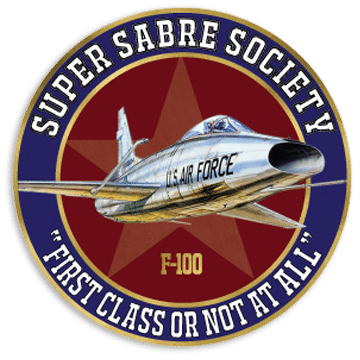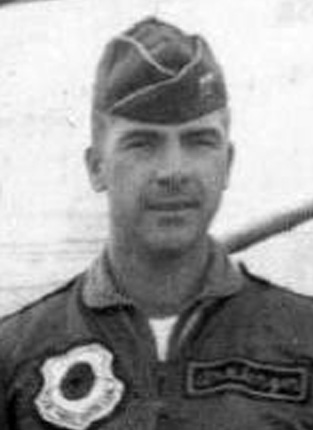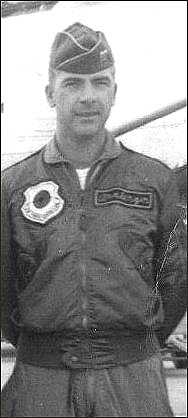Born and raised in San Francisco, Herbert Arnberger joined the U.S. Air Force in February 1953 where he began a 21-year career as a fighter pilot. He flew the F-100 with the 53rd TFS in Germany, was an instructor pilot at the Fighter Weapons School at Nellis AFB, and carried out 101 combat missions in an F-4 Phantom with the 8th TFW in Southeast Asia. Herb finished his career with the 58th TFTW at Luke AFB as an instructor pilot flying the F-104 Starfighter, which was by far his favorite plane to fly.
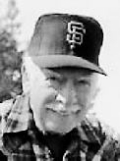 Herbert F. Arnberger (Lt. Col USAF, Ret), “Headed west” on March 16, 2010.
Herbert F. Arnberger (Lt. Col USAF, Ret), “Headed west” on March 16, 2010.
Born and raised in San Francisco, he joined the U.S. Air Force in February 1953 where he began a 21-year career as a fighter pilot. He flew with the 53rd TFS in Germany, was an instructor pilot at the Fighter Weapons School at Nellis AFB, and carried out 101 combat missions in an F-4 Phantom with the 8th TFW in Southeast Asia. Herb finished his career with the 58th TFTW at Luke AFB as an instructor pilot flying the F-104 Starfighter, which was by far his favorite plane to fly.
He was an avid baseball fan and true lover of the game. He stuck with his SF Giants through thick and thin since they moved to San Francisco in 1958. In 1998 when the Diamond Backs took the stage at the “BOB”, he admitted to following both teams and cried with us all at the 2001 World Series.
Herb loved to take his two dogs (and cat) for hikes through the high country surrounding his home in Williams AZ. He is survived by his brother Phil, 4 children: David, Laurie, Pat, and Scott, 7 grandchildren: Shawna, Jessica, Rhianna, Nicholas, David Jr, Danielle, and Brandon, and pets: Ulysses, Max, and Morris.
A Celebration of life mass was held at St. Helens Catholic Church on Wednesday, March 23, 2010. Full Honor burial followed at the National Memorial Cemetery of AZ, Phoenix AZ.
In lieu of flowers, the family suggests a donation to “Williams Needs an Angle/Dog Park” 928/635-4503 or “Waags” 928/635-2595.
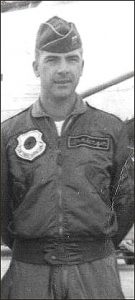 Herbert F Arnberger – Caterpillar Club Story
Herbert F Arnberger – Caterpillar Club Story
Some 40 years ago, I joined (gratefully, I might add) the Caterpillar Club. To qualify for this “club” one must parachute to relative safety from malfunctioning and/or damaged F-100, thereby ostensibly avoiding severe or fatal injury.
The occasion was one of those “fun” missions … vs. … ACM (translated = 4 F-100D Super Sabre jets against an identical 4 ship force doing Air Combat Maneuvering – further translation: Dog Fighting). I was as the Instructor Pilot with 3 “students” from the USAF Fighter Weapons School comprising Frisco Flight.
All 8 airplanes had reached 30,000 feet following different climb-out courses. I spotted Tucson, the opposing foursome, and went to afterburner power to start the “furball” encounter with superior speed. Just as my A/B lit, I felt a jolt in the control stick and soon found out there was absolutely no fore or aft movement – like my machine had no pitch control. I came out of A/B power and proceeded to fly that otherwise nice, clean (no tanks, pylons or any other junk hanging from the fuselage and/or wings) single-seat F-100D for another 40 minutes. During that time I was talking to the ground control guys along with my flight mates while scratching my own wits … from shutting off all the electrical power, turning on the autopilot, turning off the flight control damper system axis by axis, and extending the ram air turbine.
Nothing worked.
I was able to let down to 10,000 feet by using ailerons, rudder, speed brakes & throttle. I had no way to change/control altitude while wings-level except to power back and let the bird stall at 280-290 knots, a good 130+ knots above normal landing touchdown speed.
Following those exercises and realizing my J57 Pratt & Whitney engine was a fairly slow spooling (responding) beast, I figured my only reasonable course was to opt for that “nylon letdown.”
The Nellis DO came up on the radio and gave me the weather at Edwards. I then asked him if he preferred I eject over California rather than Nevada, and he came back asking if I was sure ejection was the best course of action. My reply was “If Korean jet ace McConnell couldn’t safely land a much more ‘user-friendly’ F-86H with an identical pitch control problem, I don’t really care for my odds in this machine – sir.” He said, “Copy . . . good luck.”
At that time, my FWS Ops Officer, Major Sam Johnson (who later spent 6 yrs 10 mos in the Hanoi Hilton and has been U.S. Congressman from Texas for last 15+ years), came up on the radio and said: “Tucson Leader, surface winds at Pork Chop Lake (just southeast of Indian Springs Aux Field) are 25 knots out of the North – you copy?” I came back saying “Affirmative Oakleaf Ops, I copy. And understand that wind velocity is merely double that allowed by the 101st Screaming Eagles for a combat jump!”
So at 10,000 feet above the ground over Pork Chop Lake, I slowed down to 295 knots, shut off the engine, and ejected. What an experience! Even at less than 300 knots, the airflow force when the canopy jettisoned was formidable. When the seat fired, it felt as nasty as that gnarly (practice ejection) rail I rode back at Willy in ’57 … and the chute pulling open out of the backpack was audible music to my ears.
The opening shock wasn’t too bad and the 10-minute ride down was truly interesting. Winds aloft were strong (could be heard going through the shroud lines) and may have caused the two occasions when I got into some pretty nasty oscillations. About halfway down, I saw my jet crash and explode not too far from me. I also noticed that I was no longer over Pork Chop Lake’s dry bed, but rapidly approaching some nasty looking rocky hills.
The only things I knew about parachuting were to keep your feet together and look at something distant on the horizon as the ground loomed up. From Sam’s description of the surface winds, I knew that it would be very prudent to spill/collapse the chute immediately upon landing so as to not end up being dragged into (literally) shredded meat. I made a typical fighter pilot parachute landing … heels, ass, head … all with considerable force. I did have the left riser hardware latch cover down and was able to disconnect it and thereby spill the chute without being dragged … and Sam Johnson’s weather report was right on … the surface wind was a solid 25 knots!
Within 5 minutes, the HH-43 set down within 100 yards, and I was soon on board for my first-ever helicopter ride. I had ejected at 12:15 pm and by 3 o’clock that afternoon the accident investigators had isolated the cause … a hydraulic quick disconnect line to horizontal stabilator had malfunctioned, causing the control stick to lock in the pitch axis.
After leaving the Flight Surgeon and taking his complimentary double shot of mission whiskey, I went home, took a hot bath, and reported at 8 am the next day for a 24-hour shift of Airdrome Officer … during which just about every moving part in my body ached and hurt from the previous day’s activities.
Some 30 years later my kids chipped in and treated me to a skydive “adventure.” Though it seemed a little sadistic to me at first, I gritted my teeth and agreed to it. On March 22, 1992, I did a static jump over Eloy, AZ, and rode that big red & gold rectangular chute down to a literal walk-on landing. Must admit I couldn’t rid myself of the big smile, but when one of my kids asked me if I would like to go for a second skydive jump, I came back with one of my better Clint Eastwood lines “A man has to know his limitations!”
Happy Landings,
Herb Arnberger, 55H Class, 54-17, 59H
